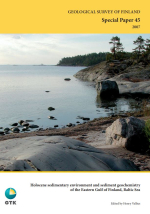Добрый день, Коллеги. Важное сообщение, просьба принять участие. Музей Ферсмана ищет помощь для реставрационных работ в помещении. Подробности по ссылке
Holocene sedimentary environment and sediment geochemistry of the Eastern Gulf of Finland, Baltic Sea / Голоценовая осадочная среда и геохимия донных отложений восточной части Финского залива Балтийского моря
The Quaternary deposits of the Eastern Gulf of Finland
The influence of ferromanganese concretions-forming processes in the Eastern Gulf of Finlandon the marine environment
Distribution of heavy metals and arsenic in soft surface sediments of the coastal area off Kotka, North-Eastern Gulf of Finland, Baltic Sea
Seafloor anoxia and modern laminated sediments in coastal basins of the Eastern Gulf of Finland, Baltic Sea
Background concentrations of trace metals in modern muddy clays of Eastern Gulf of Finland, Baltic SeaThe Geological Survey of Finland (GTK) and A. P. Karpinsky Russian Geological Research Institute (VSEGEI) are the national geoscience institutes of their countries. Both institutes have very long traditions in geological research. Also co-operation between the institutes have long traditions. This has involved many aspects of geology, not the least marine geology. As a natural consequence of this co-operation the management of both institutes decided in early 2004 to start a common project in the field of marine geology. It was decided that the area on both sides of the national border between the participating countries would be the best area for common research. The work was coordinated under a joint project called ”Sediment geochemistry and natural and anthropogenic hazards in the marine environment of the Gulf of Finland, SAMAGOL”. The project started with a workshop in St. Petersburg on June 6th 2003. It was agreed that the already available seafloor data of both institutes would be the basis of the co-operation. That data has been complemented during cruises to the study area in summers 2004 and 2006. The area of interest is situated in the eastern Gulf of Finland between longitudes 26° 27,5´E and ~28° 30 E and between latitudes 60° 00,0´N and 60° 30,0´N. The western part of this area to longitude 27° 10,8´E was chosen to be of first order of importance. During the project altogether 6 workshops have been arranged for participating scientists in both St. Petersburg and Espoo. Two major cruises have been arranged with GTK’s vessels R/V Geola and R/V Geomari and one cruise from St. Petersburg with R/V Aurora. Additionally some data have been collected during two cruises of Finnish Institute of Marine Research’es R/V Aranda. Altogether some 800 kilometres of survey lines have been surveyed during the different cruises. Depending on which vessel was used different equipment was operating. In all cases a pinger sub-bottom profiler was used. On different ships different frequencies were used but in all cases it provides good penetration in soft sediments and gives a good picture of the sediment startigraphy of the seafloor. In some cases also a side scan sonar and shallow seismic equipment was used. The acoustic data was primarily used in order to find best suitable sampling locations for sediment cores and grab samples and seconly in order to gather as good data as possible for seafloor map production. Altogether 47 surface samples were collected, of which 21 van Veen grabs and 26 GEMAX gravity cores. The grab samples were used for description of coarser and harder bottoms, with special emphasis on studies of Fe/Mn concretions. The GEMAX gravity cores were used for description of soft bottoms, usually muddy clays, as well as for geochemical sampling. Geochemical analyses were performed in the Geolaboratory of the GTK and all interpretation, writing and map production on the basis of geochemical and acoustic data were done with joint effort in Espoo and St. Petersburg. This report is a synthesis of three years of collaborative work between staffs of GTK and VSEGEI and is filling a gap in knowledge of the environmental situation of the sea and seafloor in the North-eastern Gulf of Finland. <...>




